“Stitch Glitch” is a little series of articles here on Needle ‘n Thread, where we look closely at certain aspects of particular embroidery stitches that are sometimes difficult to figure out. For example, in past Stitch Glitch articles, we’ve explored how to work isolated French knots (method 1 and method 2), how to invisibly join chain stitch circles, how to take sharp corners or make scallops with stem stitch, how to restart new threads in the middle of a line of Spanish knotted feather stitch, and a few other similar topics.
Most of the topics in Stitch Glitch are reader-generated. Normally, these articles come about because a reader wants to know “How do I…?” and a photo tutorial is generally the most helpful way to answer.
Today’s question was posed over on the Ask & Share forum here on Needle ‘n Thread, and it has to do with Hungarian Braided Chain Stitch.
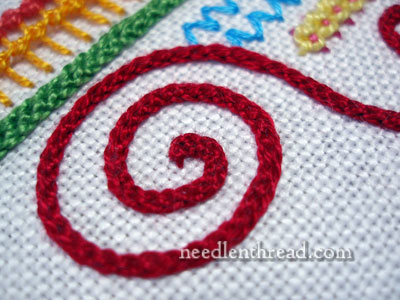
If you’re not familiar with the Hungarian Braided Chain Stitch, you might check out the video for it. It’s a fun stitch, and once you get the rhythm down, it works up pretty quickly.
Reader’s Question
So here’s the question:
I’m having trouble keeping it continuous when I change threads. Also, if I work it in a shape that meets itself (such as a circle), I can’t figure out how to join the beginning and the end and make it look natural.
It’s a two-part question: a. when to change threads in the progress of the stitch, and b. how to join circles (or a line that runs into its beginning) invisibly.
Today, I’m going to address two things: a variation on how to end a line of Hungarian braided chain stitch so that the last stitch is woven (you don’t normally see it this way in books), and part “a” of the question above – when (and how) to change out threads in the middle of working a line.
Hungarian Braided Chain Stitch – The End of the Line
When you come to the end of a line of Hungarian braided chain stitch, you have a couple options. You can end the line with the last stitch taken as usual, or you can make some slight alterations to accomplish a “weave” with the last stitch.
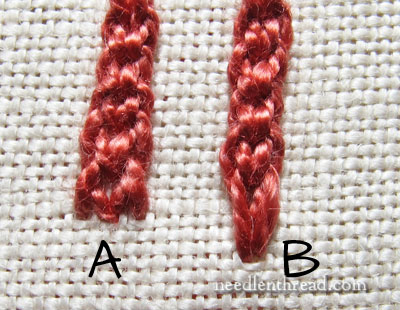
In the photo above, “B” illustrates what the Hungarian braided chain stitch looks like if you end the line, taking the stitch as usual without making any alterations. You can see that the last chain stitch looks somewhat loose and brings the line to a narrower point.
“A” in the photo above illustrates how you can end a line of Hungarian braided chain stitch so that the last stitch is woven like the rest of them.
This is how you do it:
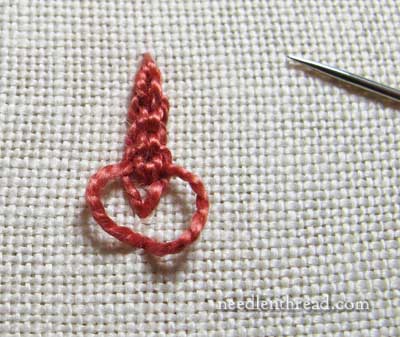
Here we are, at the end of the line. (It’s a very short line!)
I’m ready to take the last stitch, and I have the threads of the previous stitch open, so that I can easily weave my next stitch in there. If I wanted to accomplish and ending that looks like “B”, then I’d just pull the threads through at this point. But instead, I want a clean cut at the end of the line, with the last stitch woven, like “A”.
So I’m going to take one more stitch.
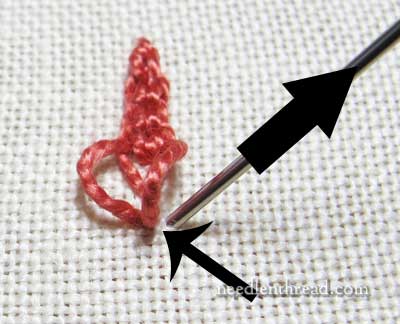
Instead of starting the last stitch, though, below the previous one, I’m going to start it next to the previous one, and kind of “tucked in” underneath the loop of the chain stitch on the right. You can see the smaller arrow in the photo above pointing to the space between the start of the previous chain stitch (that’s still open) and the needle coming up in the fabric for the last stitch.
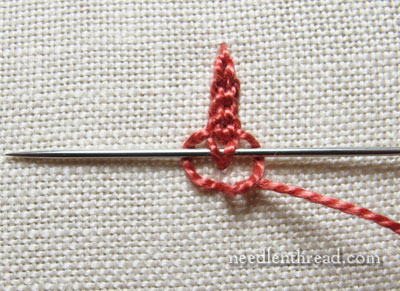
Now my needle’s in the “weaving” position of the last stitch, and I’m ready to tighten the working thread to close the loops of the previous stitch.
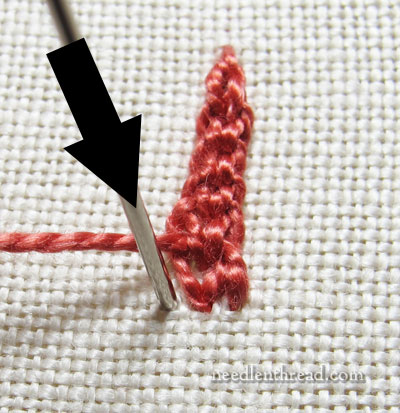
The threads are tightened up, I’ve pulled the working thread all the way through, and it’s time to end the stitch (and the line) by going down into the fabric right next to the beginning of the second-to-the-last chain stitch.
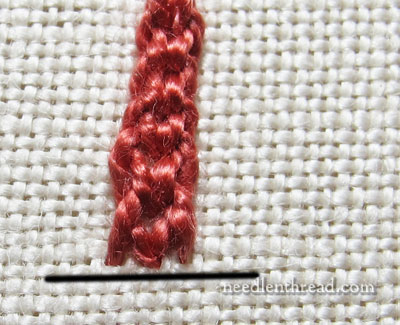
You can see that this creates a straight end to the line, with the last stitch woven like all the other stitches in the line. This is a good way to end the Hungarian braided chain stitch when you are butting the line up to another line. It makes a nice, clean finish that keeps the thickness of the whole line to the very end.
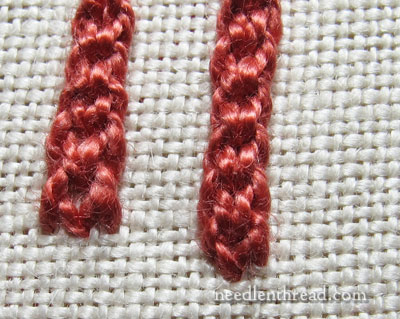
You can also make slight adjustments where you begin and end that last stitch. You can start it underneath the second-to-the-last chain stitch, closer to the center, and end up with an end that isn’t quite as straight. So, in the sample on the right in the photo above, I started and ended the last stitch higher up than the end of the previous chain stitch and tucked underneath a bit farther.
Play with various positions for that last stitch, until you get the look you like.
Starting a New Thread in a Line
Now let’s look at how to change threads in the middle of a line of Hungarian braided chain stitch.
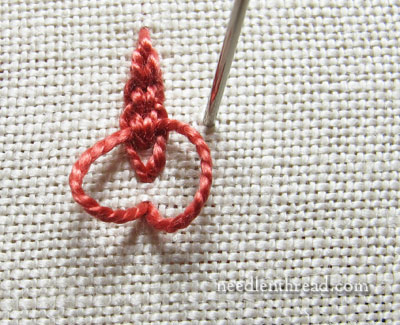
When you’re running out of thread in a line of Hungarian braided chain stitch, the time to change threads is when you arrive at this movement of the stitch. The chain is open, so that the weaving can be done easily, and we’ll actually leave it open, start the new thread, and then end the old thread.
Like this:
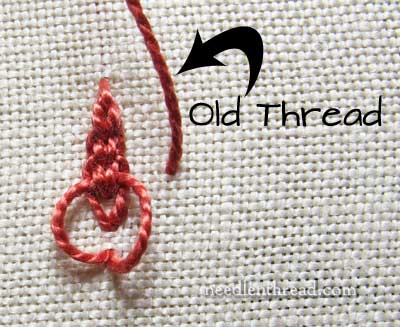
With the loops of your last chain stitch open, bring the old thread up in your fabric away from your line, preferably somewhere where it won’t make a noticeable hole or anything like that in your work. You might bring it up on another design line, for example. If you can’t find a place to bring it up to the front of the fabric, just hold it out of the way on the back of your work.
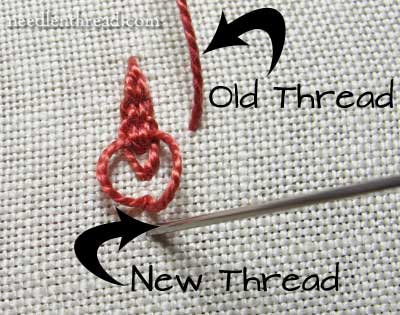
Now start your new thread and bring your needle to the front where you would normally begin the next stitch.
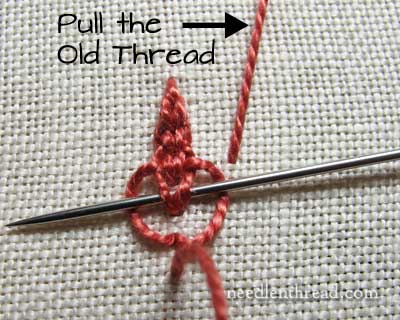
Situate your needle for the “weaving” part of the stitch, and pull on the old thread to tighten it around the needle.
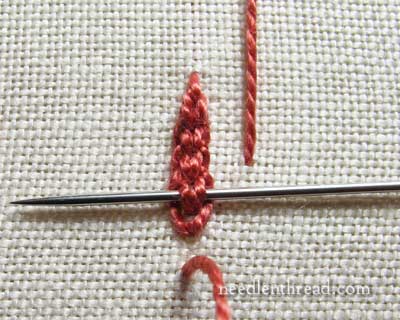
Here’s the needle with the new thread ready for the stitch, with the old thread tightened around it. Make at least two stitches with your new thread, and then…
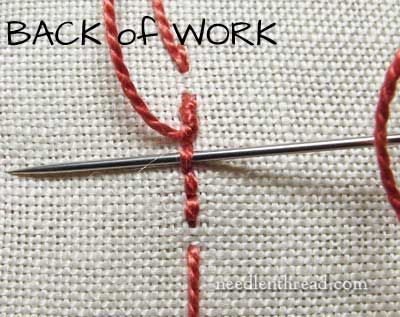
Turn the work over and weave the old thread under your stitches and snip off the excess.
And that, my friends, is how you invisibly and easily begin a new thread in the middle of a Hungarian braided chain stitch line.
Next week, we’ll see how to join circles invisibly.
If you have any Stitch Glitch questions – any individual stitch dilemmas that you’ve faced that you’d like explained – feel free to leave your question below, and if I can, I’ll write up a tutorial to help you!







Dear Mary
Thanks so much for this tutorial this is very useful information. I love the stitch glitch series and your how-to videos they have taught me so much on different embroidery stitches, thanks for your time, photos and videos you are so generous to us.
Thanks
Regards Anita Simmance
Love this stitch! I find it difficult to figure out how small or large my stitches should be when watching your videos. Is there a general number of stitches per inch to follow? I’m a counted cross stitcher from way back and have only gotten into embroidery this past year. Your videos are so easy to follow and have saved me the frustration of following stitching diagrams in books. Thank you for the help.
Hi, Jan – Thanks for your comment – I’m glad you like the videos!
Unlike counted cross stitch, there’s rarely a hard-and-fast “threads per inch” or “stitches per inch” rule with surface embroidery. How many stitches fit in a given space, or how large or small you make your stitches depends on the type and weight of thread you’re using, the look you want, and sometimes even the fabric you’re using. In the videos, I generally use perle cotton #5 to demonstrate a stitch (same with the Stitch Fun / Stitch Glitch series), because it is more visible and a lot easier to keep the stitch movements very clear. I’m always working on linen, but the type of linen varies. Usually, it’s not less than 36 threads per inch, but I do sometimes use a heavier round yarn (25 threads per inch) linen for some demos. So the thread I’m using for the demonstrations is quite heavy, and not the “normal” thread you’d use for most surface embroidery (although you can certainly use it for surface work, for bold designs). Probably your best bet is just to practice the various stitches with various weights of thread (say, 1 strand, 2 strands, 3 strands, etc., of floss, different weights of perle cotton, etc.) until you get the hang of what looks good as far as stitch length goes. Once you get into surface embroidery, it becomes sort of natural to know what size stitch is going to look right with a given weight of thread.
~MC
That’s it! Just what I needed. I never would have tried changing the threads while the last stitch is still loose.
Thank you so much, Mary. Getting this kind of detailed instruction is priceless.
— Sarah (asker of original question)
Is there a picture tutorial for the Hungarian Braided Chain Stitch from start to finish? I have looked at the video several times, tried to stitch along with it, but I am LEFT handed and it is easier for me to follow pictures. (I usually turn the pictures upside down and it works perfect.) Thanks
G’day Mary,
I’m always thankful to question askers. AND their answerer! Helpful way of learning. Thanks, Cheers, Kath.
Oh my goodness! You must have read my mind! I am working on a project with that stitch and have been fighting with that exact dilemma. You are so very helpful! Yay!
Thank you so much for this useful explanation.
I made a magnifier cover. And I embroidered Hungarian Braided Chain stitch on the surface of its cover.
But that has terrible parts .These are where I changed thread in the working line.
Now I’ll try again in this way.
This help me. Thanks Mary and asker Sarah.
Oh, dear. I wish I had found this *before* I stitched the shape of Maryland with Hungarian braided chain. I still have a stitch-glitch question, though. How do you turn sharp (but not 90 degree) corners? And join together in a circle?
Thankyou so very much Mary for this tutorial ! It was an answer to my question and a life saver !
Well, I guess I better undo my poor attempt from yesterday and do it properly! Thank you Maestro♡